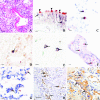Pathology, molecular biology, and pathogenesis of avian influenza A (H5N1) infection in humans
- PMID: 18403604
- PMCID: PMC2329826
- DOI: 10.2353/ajpath.2008.070791
Pathology, molecular biology, and pathogenesis of avian influenza A (H5N1) infection in humans
Abstract
H5N1 avian influenza is a highly fatal infectious disease that could cause a potentially devastating pandemic if the H5N1 virus mutates into a form that spreads efficiently among humans. Recent findings have led to a basic understanding of cell and organ histopathology caused by the H5N1 virus. Here we review the pathology of H5N1 avian influenza reported in postmortem and clinical studies and discuss the key pathogenetic mechanisms. Specifically, the virus infects isolated pulmonary epithelial cells and causes diffuse alveolar damage and hemorrhage in the lungs of infected patients. In addition, the virus may infect other organs, including the trachea, the intestines, and the brain, and it may penetrate the placental barrier and infect the fetus. Dysregulation of cytokines and chemokines is likely to be one of the key mechanisms in the pathogenesis of H5N1 influenza. We also review the various molecular determinants of increased pathogenicity that have been identified in recent years and the role of avian and human influenza virus receptors in relation to the transmissibility of the H5N1 virus. A comprehensive appreciation of H5N1 influenza pathogenetic mechanisms should aid in the design of effective strategies for prevention, diagnosis, and treatment of this emerging disease.
Figures


References
-
- Claas EC, Osterhaus AD, van Beek R, De Jong JC, Rimmelzwaan GF, Senne DA, Krauss S, Shortridge KF, Webster RG. Human influenza A H5N1 virus related to a highly pathogenic avian influenza virus. Lancet. 1998;351:472–477. - PubMed
-
- Yuen KY, Chan PK, Peiris M, Tsang DNC, Que TL, Cheung PT, To WK, Ho ETF, Sung R, Cheng AFB. Clinical features and rapid viral diagnosis of human disease associated with avian influenza A H5N1 virus. Lancet. 1998;351:467–471. - PubMed
-
- Ungchusak K, Auewarakul P, Dowell SF, Kitphati R, Auwanit W, Puthavathana P, Uiprasertkul M, Boonnak K, Pittayawonganon C, Cox NJ, Zaki SR, Thawatsupha P, Chittaganpitch M, Khontong R, Sirnerman JM, Chunsutthiwat S. Probable person-to-person transmission of avian influenza A (H5N1). N Engl J Med. 2005;352:333–340. - PubMed
-
- Normile D. Human transmission but no pandemic in Indonesia. Science. 2006;312:1855. - PubMed
Publication types
MeSH terms
Substances
LinkOut - more resources
Full Text Sources
Other Literature Sources
Medical

